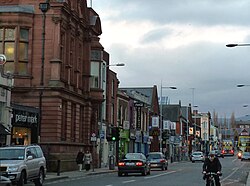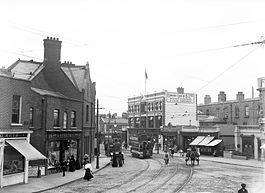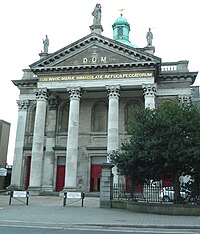Rathmines
| Rathmines Irish: Ráth Maonais | |
| County Dublin | |
|---|---|
 Rathmines Main Street | |
| Location | |
| Grid reference: | O156319 |
| Location: | 53°19’30"N, 6°15’54"W |
| Data | |
| Postcode: | D6 |
| Local Government | |
| Council: | Dublin |
| Dáil constituency: |
Dublin Bay South |
Rathmines is a County Dublin village which has become engulfed as an inner suburb on the southside of Dublin, about two miles south of the city centre. It effectively begins at the south side of the Grand Canal and stretches along the Rathmines Road as far as Rathgar to the south, Ranelagh to the east and Harold's Cross to the west.
Rathmines has thriving commercial and civil activity and is well known across Ireland as part of a traditional "flatland" - providing rented accommodation to newly arrived junior civil servants and third level students coming from outside the city since the 1930s. In more recent times, Rathmines has diversified its housing stock and many houses have been gentrified by the wealthier beneficiaries of Ireland's economic boom of the 1990s. Rathmines, nonetheless, is often said to have a cosmopolitan air, and has a diverse international population and has always been home to groups of new immigrant communities and indigenous ethnic minorities.
Name
The name 'Rathmines' has a Gaelic derivation, apparently from Ráth Maonais, meaning "Fort of Maonas". The name Maonas is perhaps derived from Maoghnes or the Norman name de Meones, after the de Meones family who settled in Dublin about 1280; Elrington Ball states that the earlier version of the name was Meonesrath, which supports the theory that it was named after the family.[1] Like many of the surrounding areas, it arose from a fortified structure which would have been the centre of civic and commercial activity from the Norman invasion of Ireland in the 12th century. Rathgar, Baggotrath and Rathfarnham are further examples of Dublin placenames deriving from a similar root.
History
Origins

Rathmines has a long history stretching back to the 14th century. At this time, Rathmines and surrounding hinterland were part of the ecclesiastical lands called Cuallu or Cuallan, later the vast Parish of Cullenswood, which gave its name to a nearby area. Cuallu is mentioned in local surveys from 1326 as part of the manor of St Sepulchre (the estate and liberty, of the Archbishop of Dublin. There is some evidence of an established settlement around a rath as far back as 1350. Rathmines is part of the Barony of Uppercross, one of the many baronies surrounding the old city of Dublin, bound as it was by walls, some of which are still visible. In more recent times, Rathmines was a popular suburb of Dublin, attracting the wealthy and powerful seeking refuge from the poor living conditions of the city from the middle of the 19th century. A substantial mansion, generally called Rathmines Old Castle, was built in the seventeenth century, probably at present day Palmerstown Park, and rebuilt in the eighteenth; no trace of it survives today.
Rathmines is arguably best known historically for a bloody battle that took place there in 1649, during the Cromwellian reconquest of Ireland, leading to the death of perhaps up to 5,000 people. The Battle of Rathmines took place on 2 August 1649 and led to the routing of Royalist forces in Ireland shortly after this time. Some have compared the Battle of Rathmines - or sometimes Baggotrath - as equal in political importance to England's Battle of Naseby. The battle brought a swift end to the ongoing Royalist Siege of Dublin.
In the early 1790s the Grand Canal was constructed on the northern edge of Rathmines, connecting Rathmines with Portobello via the La Touch Bridge (which through popular usage became better known as Portobello Bridge).
For several hundred years Rathmines was the location of a "spa" - in fact a spring - the water of which was said to have health-giving properties. It attracted people with all manner of ailments to the area. In the 19th century it was called the "Grattan Spa", as it was located on property once belonging to Henry Grattan, close to Portobello Bridge.[2] The spa gradually fell into a state of neglect as the century progressed, until disputes arose between those who wished to preserve it and those (mainly developers) who wished to get rid of it altogether. In 1872 a Dr. O'Leary, who held a high estimate of the water quality, reported that the spa was in "a most disgraceful state of repair", upon which the developer and alderman Frederick Stokes sent samples to the medical inspector, Dr Cameron, for analysis. Dr Cameron, a great lover of authority, reported: "It was, in all probability, merely the drainings of some ancient disused sewer, not a chalybeate spring." Access to the site was blocked up and the once popular "spa" faded from public memory.[3]
Easter Rising to the Civil War
On 25 April 1916, during the Easter Rising, Captain John Bowen-Colthurst, an officer of the 3rd battalion Royal Irish Rifles, went on a raiding party in Rathmines holding Francis Sheehy-Skeffington as hostage. At Rathmines Road he shot dead 19-year-old James Joseph Coade of 28 Mountpleasant Avenue. Coade had been attending a Sodality meeting at the nearby Catholic Church of Our Lady of Refuge.[4] Sheehy-Skeffington was later shot dead in Portobello Barracks.
Rathmines Church was used as a weapons store during the War of Independence. On 26 January 1920 a fire started at the electrical switchboard in the vestry. There were reports of several members of 'A' Company of the IRA Dublin Brigade entering the church during the fire to retrieve the weapons. The fire caused £30-35,000 worth of damage and completely the destroyed the dome.[5]
During the subsequent Irish Civil War, Séamus Dwyer, a pro-treaty Sinn Féin politician, was shot dead in his shop at 5 Rathmines Terrace by an unknown gunman on 20 December 1922. He had been an intelligence officer with the Dublin Brigade of the IRA during the War of Independence.
Also during the Civil War, Thomas O'Leary, a member of the anti-Treaty IRA, was shot dead by the Free State Army. His body was found on the morning of 24 March 1923 "bathed in blood, and apparently riddled with bullets, at the edge of the footpath outside the walls of the Tranquilla Convent" (now Tranquilla Park). A monument was erected in 1933 to mark the spot where his body was found.[6]
About the village

The former Town Hall is one of Rathmines' most prominent buildings. The clock on the tower is famously inaccurate and has four large apparently unsynchronised clock faces, which sometimes show different times, such that it became known locally as the "Four Faced Liar".[7] The town hall was designed by Sir Thomas Drew and completed in 1899. It is now occupied by Rathmines College of Further Education.
Rathmines is well known for the large army barracks which is located there, Cathal Brugha Barracks (known in the past as Portobello Barracks), home to many units of the Irish Army including the 2nd Infantry Battalion.
Rathmines Library was opened on 24 October 1913 following a grant of £8,500[8] from Andrew Carnegie, to a design by architect, Frederick Hicks.[9]
Churches
- Church of Ireland: Holy Trinity Church 1828), designed by John Semple in the Gothic Revival style. It s nicknamed 'the Black Church' because the local calp stone used in it construction turns black in the rain.
- Roman Catholic: Mary Immaculate, Refuge of Sinners Church, with a prominent copper dome
- Baptist: Grosvenor Road Baptist Church.[10]
| ("Wikimedia Commons" has material about Rathmines) |
References
- ↑ Ball, F. Elrington History of Dublin Vol.2 1903 Alexander Thom and Co. p.100
- ↑ Handcock, William Domville (1899). The History and Antiquities of Tallaght In The County of Dublin. Dublin: 2nd Edition. http://www.chaptersofdublin.com/books/Handcock/tallaght14.htm.
- ↑ Irish Times, Letters to the Editor, July 1872
- ↑ http://www.awm.gov.au/journal/j39/kildea.asp
- ↑ http://comeheretome.com/2013/08/05/the-rathmines-church-fire-1920/
- ↑ http://comeheretome.com/2013/02/15/thomas-oleary-of-armstong-street-harolds-cross/
- ↑ Kapila, Lois (4 May 2016). "A Struggle to Keep Time". https://www.dublininquirer.com/2016/05/04/a-struggle-to-keep-time. ""Going back years ... it's always been known as the four-faced liar," said ... vice principal of Rathmines College. "The clocks were never fully coordinated.""
- ↑ "Archived copy". http://dublincitypubliclibraries.com/story/rathmines-library-100-years-heart-community.
- ↑ http://dia.ie/works/view/36650/building/CO.+DUBLIN%2C+DUBLIN%2C+RATHMINES+ROAD+LOWER%2C+NO.+167+%28CARNEGIE+FREE+LIBRARY+%26+TECHNICAL+INSTITUTE%29
- ↑ Grosvenor Road Baptist Church.
- Maitiú, Séamas Ó (2003). Dublin's Suburban Towns 1834–1930. Four Courts Press. ISBN 9781851827237.
